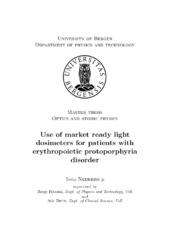Use of market ready light dosimeters for patients with erythropoietic protoporphyria disorder
Master thesis
Permanent lenke
https://hdl.handle.net/1956/16065Utgivelsesdato
2017-06-21Metadata
Vis full innførselSamlinger
Sammendrag
Erythropoietic protoporphyria (EPP) disorder causes severe pain in the skin when patients are overexposed to light, particularly blue light. These patients can only stay exposed to sunlight for a short amount of time, and since there are few ways to protect against visible light, their life quality is considerably reduced. Estimation of accumulated dose is traditionally done by comparing exposed time to an individual maximum time; only found by accident after overexposure. No dosimeter is currently in use, and no correlation between weather quantities, like UV index, have previously been investigated. Phillips makes a wrist wearable device - ActiWatch Spectrum Plus - for measuring activity and exposure to light using photodiodes in the visual spectrum. The SunSprite company makes SunSprite; a clip-on device meant to improve sleep and mood by measuring time spent in light stronger than 10000 lx. It communicates to an app, where more data is displayed. The SunSense company are currently developing the SunSense RGB; also clip-on device with photodiodes in the visual spectrum, and with dosage calculator in an app that communicates with the devices. In this thesis we classify these three devices, and investigates if they can be used by EPP patients to measure light doses. Further on, we investigate if a dose-rate index for EPP patients have any correlation with UV index, or other radiation quantities that are easily available as forecast. We find that the SunSprite does not provide any way of displaying useful information for EPP patients. ActiWatch Spectrum Plus is proven to be unreliable as an irradiance sensor, due to the sensor being in a hole with no diffuser on top. The prototype from SunSense has a sensor that could be used by EPP patients, and is fairly stable with regards to responsivity. It is found that the device could benefit from a better cosine response; either through raising the sensor closer to the diffuser, or via another diffuser. We also define two EPP light indices that can be helpful for EPP patients, PLi and optimized PLi. The correlation between these two indices and the UV index is found to be poor, but the correlation with the illuminance is good, perhaps making it possible to use one channel lux-meters to monitor EPP light doses. The daily accumulated dose does not correlate with the maximum UV index, but correlation with the average UV index between 13:00 and 15:00 was found, suggesting that some weather forecasts can be used to plan the day.
